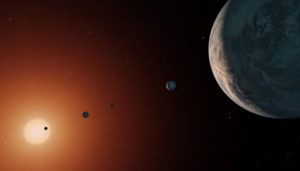A new study suggests that the seven-planet dwarf star could be much older than the Sun.

NASA / JPL-Caltech
Since March’s announcement that the little red dwarf star TRAPPIST-1 hosts seven small exoplanets, astronomers have been working hard to discover everything they can about the star. One of the crucial bits of information they’ve been seeking is the star’s age. But TRAPPIST-1 is coy. The star is among the smallest, faintest M dwarfs, and such stars are hard to date.
Reporting in an upcoming Astrophysical Journal, Adam Burgasser (University of California, San Diego) and Eric Mamajek (JPL and University of Rochester) pulled together several observations of TRAPPIST-1, and of red dwarfs more broadly, to tackle the age question. They considered more than a half dozen different stellar characteristics to determine which were the most illuminating. They settled on the star’s chemical composition, its motion through the galaxy, and how often it flares.
None of these parameters gave specific results, but using them the team estimates that TRAPPIST-1 is between 5.4 and 9.8 billion years old. That’s consistent with a previous estimate of between 3 and 8 billion years by Rodrigo Luger (University of Washington, Seattle) and others, based on the star’s activity level and its spin. But the new study leans more toward the higher end of the range than many had suspected.
One reason for that shift to older ages is the star’s activity. Given the star’s output of high-energy radiation, previous work had suggested that TRAPPIST-1 is fairly young. But Burgasser and Mamajek found that, when compared with more than 200 active M dwarfs in the solar neighborhood, TRAPPIST-1 is actually pretty lethargic — its relatively weak emission suggests that it’s older than at least half these stars.
The advanced age is a bit odd, because scientists had wondered whether the planetary system would be stable for more than a billion years. The dwarf’s seven exoplanets orbit in a resonant chain, their movements tightly coupled by gravity. Imbalances in this chain would easily yank planets out of line.
Although it might sound good for habitability, the passage of so many billions of years may well have done in all but the outermost exoplanets. All seven worlds orbit closer to TRAPPIST-1 than Mercury does to the Sun. So close to the star, the planets have been bombarded by dangerous radiation over the last several billion years — enough to strip the innermost worlds of Earth-like atmospheres, and perhaps enough to rip an ocean’s worth of water off all but the two outermost planets, only one of which lies in the putative habitable zone. Thick atmospheres might save the planets, but astronomers will likely have to wait for the James Webb Space Telescope, launching in late 2018, before they can clearly detect the worlds’ atmospheres.
The paper is a nice synthesis of research on TRAPPIST-1 and its place among M dwarfs, and I encourage you to read it if you’re interested in this topic. You can also read more about the result in JPL’s press release.
Reference: A. J. Burgasser and E. E. Mamajek. “On the Age of the TRAPPIST-1 System.” Accepted to Astrophysical Journal.
The biggest astronomy event of the year is coming: the total solar eclipse of 2017! Prepare with our comprehensive eclipse guide.
 0
0









Comments
You must be logged in to post a comment.